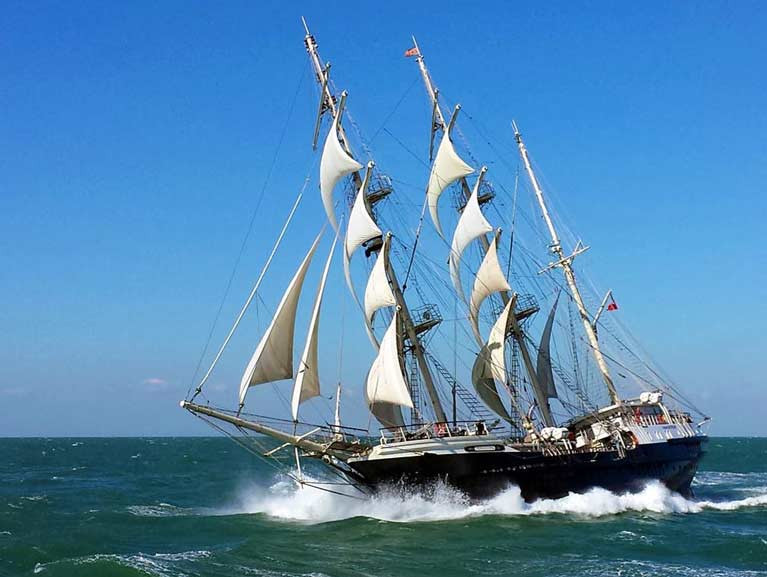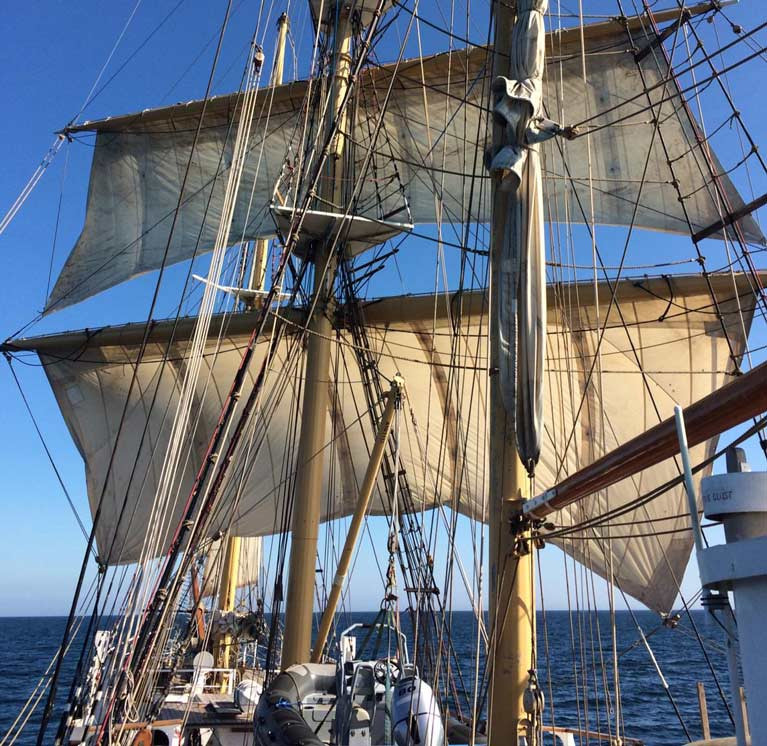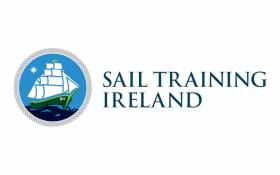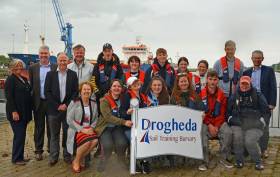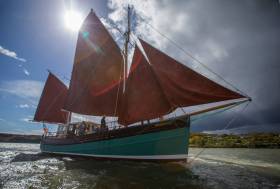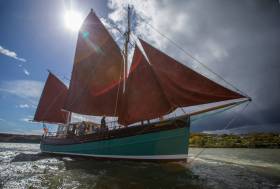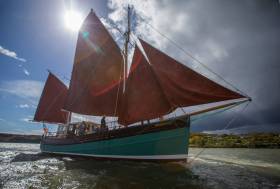Displaying items by tag: Sail Training Ireland
Sail Training Ireland Weathers the Pandemic Storm & Looks Forward to Big Return in 2022
It has been a challenging year for sail training in Ireland, with 2020’s slate of tall ships voyages cancelled due to the pandemic and this summer’s schedule also looking unlikely.
But as chief executive Daragh Sheridan acknowledges in the Sail Training Ireland Annual Report 2020, which has just been published, the charity has been weathering the storm thanks to the support of its funders, and the dedication of its own team and vessel operators alike.
“With the mass vaccination being rolled out we look forward to 2022 with great optimism,” he writes. “We will be aiming to bounce back strongly, thanks to commitments from funders and new sources of funds which will see several new projects running alongside all our usual voyages.”
The report, which can be downloaded HERE, also details the experiences of some of these who were able to set sail on one of the few excursions that took place last summer — the Darwin200 voyage around the UK in preparation for the upcoming round-the-world trip following Charles Darwin’s journey on HMS Beagle.
Sail Training Ireland Announces 2021 Tall Ships Voyage Programme (Downloadable Here!)
Sail Training Ireland has announced the launch of its 2021 Tall Ship voyage calendar (download below) coming after the disappointing decision to have to cancel its 2020 voyages due to COVID-19.
Next year will see some new and exciting projects happening alongside Sail Training Ireland's usual local bursary scheme voyages.
Most of the charity’s voyages have generous bursaries available to reduce the cost to those who may not be in a position to avail of the opportunity because of their circumstances.
Due to pent up demand arising from this year, STI says it is advisable to book early.
“One of the key skills that sail training teaches is resilience. Our trainees, crews, supporters, sponsors, volunteers, vessel operators and the Board and staff have had their spirit tested during 2020 and come through it even stronger. We cannot wait for the 2021 season to start and will be working hard to make it the best one ever". "Please come and join us”, said Daragh Sheridan of Sail Training Ireland at the launch.
2021 Voyage Calendar (download below)
Despite having to cancel all voyages this year, Sail Training Ireland will publish its programme for next year in the next week. The organisation’s Chief Executive says they have been in discussion with vessel operators and will have an exciting new programme with a number of headline developments writes Tom MacSweeney
“We want to make it clear that our programme will continue and we are particularly anxious to encourage participation and looking to introduce new participants to sailing.”
 Trainees learn new skills onboard a Tall Ship
Trainees learn new skills onboard a Tall Ship
Sail training vessel operators have also suffered the impact of the pandemic, with vessels being laid up and crews furloughed in the UK.
Daragh Sheridan, STI CEO, is this week’s Podcast guest. A solo sailor himself, a Laser winter sailor for many years in Howth and the recent new owner of an RS Aero, he has been able to get back on the water, which makes him all the more keenly aware of the disappointment for trainees on the voyage cancellations this year. When I talked to him, the positive news was that STI is about to launch its programme for next year, offering all this year’s trainees and new applicants the opportunity to switch to what he says will be an exciting programme next year.
This week’s Podcast below
Sail Training Ireland Shortlisted For Charity Impact Awards
Sail Training Ireland has been shortlisted for the Charity Impact Awards 2019 which are run by The Wheel, the national association of community and voluntary organisations, charities and social enterprises.
As part of the next step there is a public vote accounting for one third of the total.
Friends of Sail Training Ireland are asked to follow the link to the Charity Impact Awards website and submit their vote: select Browse Entries, then Sail Training Ireland, Learn More and then Vote. You will then receive an email to verify your vote.
Sail Training Ireland has also launched the first edition of its new newsletter, Tall Ships And Friendships, which is now available online.
The newsletter is hoped to become a forum for everything sail training, and this inaugural edition features reflections from some of those who embarked on its tall ship sail training voyages over the past year.
Be sure to visit the Sail Training Ireland website in January for details of next year’s sail training voyages — a number of Transition Year voyages associated with Gaisce/The President’s Award are detailed in the newsletter.
The sixth annual Drogheda Sail Training Bursary Voyage set sail on Sunday 9 June when a new group of local teenagers boarded the tall ship Brian Ború at Fiddle Case Pier.
The teens, aged between 15-17, were nominated by their local schools Greenhills, Sacred Heart, St Mary’s and Gormanston and were raring to give it a go, having heard great things about the experience from previous trainees.
Skipper Peter Scallan greeted the trainees and quickly got to work with the safety briefing and emergency drills. Within hours the trainees, who were all strangers to each other, had begun to mix well and were busy in the ship’s galley preparing dinner.
Afterwards they assisted the captain in preparing the navigational plan for the week ahead and spent their first night onboard in Drogheda.
At 8am the following morning their adventure began. The first stop was Clogherhead — and a VIP tour of the village’s RNLI station to see one of Ireland’s newest lifeboats, the Shannon class Michael O’Brien.
From there the journey took them to Lambay Island — home to a colony of wallabies — then on to Howth.
The trainees had by now become a great team and strong friendships were forming. They were learning and growing in confidence with every nautical mile — 54 at this point.
Scrubbing the decks (also known as ‘Happy Hour’), preparing meals, keeping watch, writing logs, the young crew were working flat out.
After passing Ireland’s Eye and the Bailey Lighthouse, the Brian Ború arrived in Wicklow for some well-earned relaxation time spent fishing, swimming and enjoying the beauty of life at sea.
From Wicklow, the return passage took them to Dun Laoghaire Harbour for the night, then another overnighter, this time at Malahide Marina for some yacht-spotting, before the final 26 nautical miles homeward bound last Friday morning 14 June.
The newly skilled sailors received a warm welcome home at Harbourville from family, friends and bursary schene sponsors Irish Cement, Fast Terminals, Louth County Council and Drogheda Port Company.
The sponsors in association with Sail Training Ireland presented trainees with a certificate of achievement and commended them on embarking on this challenging adventure.
Next year’s voyages promise to be every bit as exciting. If you are interested in taking part, contact Drogheda Port Company for details.
Sail Training Ireland Awards & Season Launch This Saturday
Sail Training Ireland will hold its seventh annual prize-giving and season launch event this Saturday 2 February at the Mansion House in Dublin, courtesy of Lord Mayor of Dublin Nial Ring.
The event will see awards being presented to trainees who made an outstanding contribution to their individual voyages and to the charity in 2018.
Sail Training Ireland helps young people from all backgrounds and abilities to participate on training and self-development programmes on tall ships.
The organisation is the beneficiary of new State funding to the tune of €85,000 for young people with disabilities and from disadvantaged backgrounds to embark on tall ship training voyages.
Sail Training Ireland chief executive Daragh Sheridan hailed the announcement as “a hugely positive development” that would enable the charity “to offer the life-changing opportunity of sail training voyages to even more young people across the island of Ireland”.
Sail Training Ireland Chief Executive Welcomes New State Funding For Youth Voyages
Sail Training Ireland chief executive Daragh Sheridan has hailed the recently announced Government funding for young people with disabilities and from disadvantaged backgrounds to take part in tall ships training voyages as “a hugely positive development for the charity”.
Sheridan added that the funding “will enable [Sail Training Ireland] to offer the life-changing opportunity of sail training voyages to even more young people across the island of Ireland.
“It will also mean that we can expand our inclusion voyages that ensure people of all abilities can participate.
“I believe that the Government decision was positively influenced by the highly respected individuals and organisations who already support us.”
Sheridan also expressed his thanks to Paul Kehoe, Minister of State at Department of Defence, and Finian McGrath, Minister of State for Disability Issues, for their support.|
More Details Of New Funding For Sail Training Opportunities
Minister of State with responsibility for Defence, Paul Kehoe, has announced further details of the new funding approved by Cabinet young people with disabilities and from disadvantaged backgrounds to embark on tall ship training voyages.
Joined by Minister of State with responsibility for Disabilities, Finian McGrath, Minister Kehoe announced the provision of a grant of €85,000 in 2019 and again in 2020 which will go towards youth development in Sail Training Ireland’s charitable programme.
The objective of sail training is youth development rather than just teaching people to sail, which the ministers underline as an important distinction.
In 2018, Sail Training Ireland placed 341 young people on sail training vessels, over 90% of whom were from disadvantaged backgrounds.
Sail Training Ireland does not own or operate is own vessels, but charters as required. This is a different model to the state’s previous sail training vessel, the Asgard, which sank off the coast of France in 2008.
Trainees are selected by nominating organisations such as the HSE, Garda Diversion Projects, Tulsa, Irish Wheelchair Association and the Irish Refugee Council. A total of 37 nominating organisations provided trainees for placement in 2018.
Skills such as communication, leadership, confidence and teamwork are all developed when on board a sail training vessel.
Sail Training Ireland also facilitates young people with a disability to avail of the sail training experience. In 2018 over 25% of those placed on voyages were young people with a disability.
In terms of gender balance, of the 341 trainees in 2018, 185 were young men with 156 young women. Trainees have also come from over 25 counties in Ireland which includes five in Northern Ireland.
The new funding for this year and next has the potential to deliver an additional 50 places for young people from disadvantaged backgrounds in each of those years.
Speaking at an event onboard the Brian Ború vessel at Poolbeg Yacht Club in Dublin today (Friday 11 January), Minister Kehoe commented: “Many of the young people that will selected for these projects have experienced significant difficulties and hardships in their lives.
“In some instances, the opportunities provided by Sail Training Ireland have allowed young people to turn their lives around.
“I would like to commend the work that Sail Training Ireland has undertaken in recent years and wish them well as we face into a new year.”
Minister McGrath added: “Sail Training Ireland once again have shown their commitment to working with people with a disability and I am delighted to be part of today's event.
"Officials from the Department of Defence are engaging with the chief executive and chairman of Sail Training Ireland to ensure child safeguarding procedures are in place and to finalise appropriate governance and financial requirements, in advance of the grant being paid.
"At the end of two year period, a review of the outputs and outcomes of the expenditure will be undertaken by my department."
New Sail Training Funding For Disabled & Disadvantaged Youth
This week sees the announcement of new funding approved by Cabinet for young people with disabilities and from disadvantaged backgrounds to have opportunities to embark on tall ship training voyages.
Minister of State with Responsibility for Defence, Paul Kehoe, and Minister of State with Responsibility for Disabilities, Finian McGrath, will launch the new youth development funding in conjunction with Sail Training Ireland from the Brian Ború docked at Poolbeg Yacht & Boat Club in Ringsend tomorrow lunchtime, Friday 11 January.
It’s believed that the new initiative would benefit young people many of whom have been referred to the sailing charity by judges, Garda, Tusla and other groups working with vulnerable and disadvantaged children.
In November, Sail Training Ireland was shortlisted in the National Inclusion Awards, welcoming the news as “recognition of the fact that 86 people or 25% of our trainees [in 2018] had a disability of some kind”.
Sail Training Ireland Shortlisted For National Inclusion Award
Sail Training Ireland has been shortlisted for the 2018 National Inclusion Awards under the Adventure category.
The not-for-profit initiative, which gives people from various backgrounds opportunities to crew tall ships, welcomed the news as “recognition of the fact that 86 people or 25% of our trainees this year had a disability of some kind. Well done to all for taking on the adventure.”
Sail Training Ireland also thanked its supporters for their continued efforts, which have been “instrumental in making this opportunity available to people from all backgrounds and abilities”.
The winners of this year’s National Inclusion Awards will be announced on Wednesday 28 November.


























